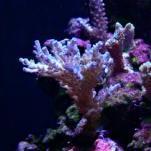-
Posts
5,969 -
Joined
-
Last visited
Content Type
Profiles
Forums
Gallery
Everything posted by blueheaven
-
As the school holidays are here, I am contributing my free time to write articles to help beginners understand better of the different aspects of reefkeeping. This is an article that I have written some time ago. Hope it helps. Here's my article on Sandbeds Many people have conflicting ideas on setting up a refugium, especially one with a sandbed. I have seen set ups with a DSB (Deep Sand Bed) of about 4" to 6" thick. And sadly, a lot of people think that just by putting in some sand and macroalgae, they have a working refugium. I firmly say NO. In my opinion, its important to know and understand the thing you are doing before doing it. Although sandbed dynamics are still being researched, I will provide the current information available. Bacteria and zones The main purpose of adding a sandbed is to allow bacteria to colonise on its surface. Many people think of diseases when the word "bacteria" is mentioned. The bacteria we are talking about here are those that convert certain compounds to another form. There are mainly 2 groups of bacteria, namely the aerobic and anaerobic. Aerobic refers to the presence of air and anaerobic refers to the absence of air. And the confusion comes as each group will split into 2 groups. The 2 groups are the autotrophs and heterotrophs. Autotroph meaning the organism is able to synthesize its own food from inorganic substances and heterotroph meaning an organism that cannot synthesize its own food and dependent on organic substances. Basically, there are 3 groups of bacteria we are interested in. The aerobic autotrophs, aerobic heterotrophs and anaerobic heterotrophs. The aerobic heterotrophs will break down organic substances into inorganic compounds (eg. ammonia). These inorganic compounds are then taken up by aerobic autotrophs which will perform nitrification. The anaerobic heterotrophs will perform denitrification. The aerobic autotrophs are usually found on the suface layer of sand since they need oxygen and light to synthesize food. The other area around the top 1/3 of the sandbed will be colonised by aerobic heterotrophs. And as oxygen levels decrease down the sandbed, anaerobic heterotrophs will colonize there. An important point to note is that anaerobic zone actually consisted of 2 different zones. The zone that has oxygen concentrations of 0.5-2 ppm (test conducted by Sam Gamble) is named as the "anoxic" by Bob Goemans. This zone will contain facultative (bacteria that live with or without oxygen) bacteria that fully oxidize nitrate back to nitrogen gas. The other zone that has no oxygen at all will consist of anaerobic heterotrophs with only convert nitrate into ammonium which is a better fertilizer than nitrates for algae. This explains why I think that really deep sandbeds are not good as your ultimate goal is to achieve an anoxic zone. The recommended sandbed depth should be 3"-3.5" Grain size and size of refugium Normally, people try to use the smallest grain size for their sandbed. This differs between systems and I shall explain. It is good to have small grain size as it increases the surface area for bacteria to colonise. But this only applies to systems which have the skimmer output there or any other source of oxygenated water. If the area is in lowly oxygenated water, the oxygen diffusion will be limited to the upper layers. For those people who have lowly oxygenated water in their sandbeds, it is advised to use bigger grain sizes and a bigger sandbed. This will allow oxygen to diffuse deeper faster. Infauna and their importance The word "infauna" is new to many people. It actually means the fauna (animals) IN the sandbed. So why do these animals make such an importance in sandbeds? The infauna consist of mini-stars, micro-stars, worms, flatworms and a myraid of other small animals. These infauna will constantly shift the sand and their action will prevent the sandbed from reaching a completely anaerobic zone. This action also ensures that the sand does not clump together as a result of precipitation and bacterial actions. I really hope that LFS will start to bring in recharge kits consisting of these infauna that reefers can add to their sandbed. If not, these animals will come as hitchhikers on live rock. Quorum Gene Sensing This is a relatively new concept to sandbed dynamics and it involves bacteria. Quorum sensing is actually a way bacteria produce this gene that senses the population of the bacteria. The researched bacteria is the Vibiro spp. and it is found that the bacteria will produce toxins that kill human cells in high populations. It will be interesting to do research on the nitrifying bacteria and see whether they will be detrimental in high population sizes. And we could see whether we can stop the production of the Quorum gene . This comes to the end of my article and I hope readers will find this useful and I will type another article on different types of sumps next. The top information on different types of bacteria and zones are from Sand Mail, FAMA Aug 2004 by Bob Goemans
-
Hi guys, if there are any topics or aspects of reefkeeping that you do not quite understand, I will do my best to write up a detailed yet easy to comprehend article on it. So far I have done an article on sandbeds. So feel free to state any topics that you do not understand here
-
They obviously do not know what a baffle is for
-
Hi guys, my friend recently got a new mitsubishi handphone and said that its FOC as his father is a member of singtel for 5 years. Anyone knows about this promotion? And is there any more free handphone giveaways?
-
Do I hear frags?
-

Easy, no hassle Ricordia Propagation!!!!
blueheaven replied to blueheaven's topic in General Reefkeeping_
Hi, when my mushies are fragged, the frags will appear a little translucent for a few days but after that, they usually return to normal colours. You might want to give them a bit more lighting so as to promote zooxathellae production. Wish you success with your frags -

Pink mushroom on new bougth green mushroom rock
blueheaven replied to jyilailong's topic in Soft Coral Forum
These are quite common IMO but I do not know the latin name -

Pink mushroom on new bougth green mushroom rock
blueheaven replied to jyilailong's topic in Soft Coral Forum
You might want to post a close up for easier id -
Write articles instead Share your views on this in another topic. If you want to learn more about sandbeds and bacteria, you can read my article for a start
-
What has dentrivores got to do with phosphate? Anyway, yes skimming removes PO4 but only to a very small extent. The skimmate you see is not the phosphate mind you. We cannot run away from phosphate even if you use RO/DI as it comes with food as well. Using rowa or contra has already proven to be useful as it targets the PO4 directly and can rapidly absorb PO4 compared to your skimmer.
-

Easy, no hassle Ricordia Propagation!!!!
blueheaven replied to blueheaven's topic in General Reefkeeping_
Just doing my best to prevent such incidents Lets get back to topic -

Easy, no hassle Ricordia Propagation!!!!
blueheaven replied to blueheaven's topic in General Reefkeeping_
Dun really want to say in case the hogging tub incidents happen again You can find the answer somewhere in SRC -
These are bulbs that came together with my Hilux set I have since changed to Phoenix bulbs as I do not want to supplement with actinics
-
sure knows how to choose
-

can elephant ear survive on lighting only
blueheaven replied to LIM CHYE HUAT's topic in Soft Coral Forum
wonder why its called elephant ear? like elephant have such hairy ears -

can elephant ear survive on lighting only
blueheaven replied to LIM CHYE HUAT's topic in Soft Coral Forum
Yup you know what happens next An elephant ear can contract into a ball in just 3 seconds -

what causes coral bleaching?
blueheaven replied to shoelevy's topic in New to the Marine Aquaria Hobby
Corals bleach when they expel zooxathellae mainly due to poor water quality, not enough lighting and high water temperatures -
Hi guys, I still have 2 pcs of 150w Dymax 10kk bulbs to sell. Really need to clear these fast. I have only used it for 15mins Collection can be made anywhere but best if at the East side Selling for $50 each
-

Duration of Life rocks in tank.
blueheaven replied to zorden's topic in New to the Marine Aquaria Hobby
Hehe..Yah, as long as it works, don't care about the small details -
Why not make it an all round view tank instead? Maybe next time we can share our progress of our propagation systems?
-
Need at least 50 posts Thanks for all your participation
-

Duration of Life rocks in tank.
blueheaven replied to zorden's topic in New to the Marine Aquaria Hobby
I base my coralline project on GARF You might want to read their research findings as well -
Today I covered the glass portion in my refugium that the sand is exposed to light with black paper. Hopefully this will promote the heterotropic anaerobic bacteria and encourage worm burrowing
-

LFS Stock Update 24th - 30th Oct
blueheaven replied to minsmarine's topic in Weekly LFS Stocks Report / LFS Info Centre
Any updates on Pasir Ris stock?

